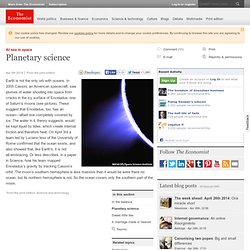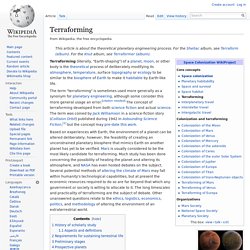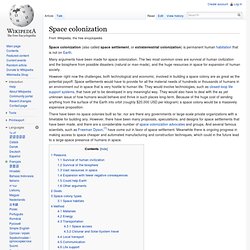

The Surprisingly Strong Case for Colonizing Venus. Why worry about building a colony on Mars when instead you could float one high above the surface of Venus?

Science fiction writer Charles Stross recently revived the idea of building a Venutian colony when he suggested, cheekily, that billionaires ought to be compelled to donate to massive humanity-improving projects. He suggested two: a Manhattan Project-like focus on developing commercial nuclear fusion, or the construction of a floating city on Venus. The second planet from the Sun might seem like a nasty place to build a home, with a surface temperature hot enough to melt lead and an atmosphere so dense it would feel like being submerged beneath 3000 feet of water. But the air on Venus thins out as you rise above the surface and cools considerably; about 30 miles up you hit the sweet spot for human habitation: Mediterranean temperatures and sea-level barometric pressure. If ever there were a place to build a floating city, this would be it. Atmospheric pressure is also crucial. At sea in space: Planetary science. Earth is not the only orb with oceans.

In 2005 Cassini, an American spacecraft, saw plumes of water shooting into space from cracks in the icy surface of Enceladus, one of Saturn’s moons (see picture). These suggest that Enceladus, too, has an ocean—albeit one completely covered by ice. The water in it, theory suggests, would be kept liquid by tides, which create internal friction and therefore heat. On April 3rd a team led by Luciano Iess of the University of Rome confirmed that the ocean exists, and also showed that, like Earth’s, it is not all-embracing. Dr Iess describes, in a paper in Science, how his team mapped Enceladus’s gravity by tracking Cassini’s orbit. NASA Is Taking Steps That Could Lead to Colonization of Planets [Video] In a process that is out of this world, NASA is making plans to bring water and oxygen to the Moon and Mars in steps that could ultimately lead to colonization of other planets.
![NASA Is Taking Steps That Could Lead to Colonization of Planets [Video]](http://cdn.pearltrees.com/s/pic/th/taking-colonization-planets-76969478)
It is just like something that happens in a sci-fi movie or a futuristic video game. Currently, shipping raw materials back and forth between Earth and neighboring solar system bodies is an incredibly expensive process, largely thanks to Earth’s gravity. In fact, according to a NASA report from 2009, it can take as much as $10,000 for each pound of space shuttle cargo to blast off. Given that a gallon of water is 8.33 pounds, that means astronauts had better appreciate each bottle of water they drink like it’s the last water on, well, the International Space Station. It is no large wonder that NASA seeks to find newer and more cost-efficient ways of bringing water and oxygen to Mars and the Moon.
Canada’s Artemis Jr. rover By Jonathan Holowka Sources: Extreme TechExtreme TechNASAGizmodoGeek O SystemAbout.com. Giant asteroid lets off steam. Astronomers have spotted jets of steam coming from opposite sides of the largest asteroid in the solar system.

The twin plumes of water vapour erupting from the space rock were noticed during a series of observations with the Herschel Space Telescope between October 2012 and March last year. Researchers said the steam was produced either by the warmth of the sun vaporising ice beneath the surface, or a form of volcanic activity that is forcing water out of the asteroid's warm interior. Terraforming. An artist's conception shows a terraformed Mars in four stages of development.

Terraforming (literally, "Earth-shaping") of a planet, moon, or other body is the theoretical process of deliberately modifying its atmosphere, temperature, surface topography or ecology to be similar to the biosphere of Earth to make it habitable by Earth-like life. The term "terraforming" is sometimes used more generally as a synonym for planetary engineering, although some consider this more general usage an error. [citation needed] The concept of terraforming developed from both science fiction and actual science. The term was coined by Jack Williamson in a science-fiction story (Collision Orbit) published during 1942 in Astounding Science Fiction,[1] but the concept may pre-date this work.
History of scholarly study[edit] In March 1979, NASA engineer and author James Oberg organized the First Terraforming Colloquium, a special session at the Lunar and Planetary Science Conference in Houston. Mars[edit] Space colonization. Space colonization (also called space settlement, or extraterrestrial colonization) is permanent human habitation that is not on Earth.

Many arguments have been made for space colonization. The two most common ones are survival of human civilization and the biosphere from possible disasters (natural or man-made), and the huge resources in space for expansion of human society. Terraforming Earth.
Terraforming The Moon. Terraforming Europa. Evidence for Water Ice at Mercury's Poles. Thirty-year-old Data Offers New View Of Venus. (ISNS) -- In 2010, the European Space Agency’s Venus Express orbiter observed that twice as many hydrogen atoms as oxygen atoms were escaping from Venus into space.

This was the first evidence that Venus might once have harbored puddles, pools and even lakes of liquid water on its surface. Now, a new study suggests that Venus could be storing some amount of intact water molecules within its mantle. To determine this, Justin Filiberto, a geologist at Southern Illinois University in Carbondale, compared what geologists know about the composition of rocks on the surface of Venus with rock formation processes here on Earth.
His results, which appeared in the December issue of the journal ICARUS, suggest that some types of rocks on Venus could only have formed in the presence of water and carbon dioxide. Between 1981 and 1984, the USSR launched six missions to Venus.